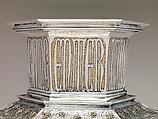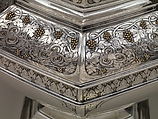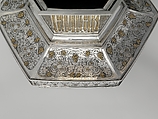Vase
Designer Arthur J. Stone American
Herbert Taylor
These exquisite altar vases (see also 2011.347) are among the finest known examples of American Arts and Crafts silver. They were designed by the silversmith Arthur J. Stone, who trained and worked in England and Scotland before immigrating to the United States in 1884. Made for use on the altar of the chapel at Pomfret School in Pomfret, Connecticut, the vases were commissioned by Lydia Clark of Philadelphia in memory of her son, George Newhall Clark, who died in 1906, two years after he graduated from Pomfret. Refined and opulent, the vases display Stone's rich ornamental vocabulary as well as his exceptional technical skills. The bold hexagonal bodies were hand-raised to Stone's design by his workshop's leading craftsman, Herbert Taylor, and then painstakingly chased and gilded by Stone himself. Appropriate to chapel plate and to the ideology of the Arts and Crafts Movement, the panels of interlaced grapevines, trefoil-and-leaf banding, and other ornamental motifs reference medieval sources. On the neck of each vase a verse from the Book of Common Prayer is chased in Gothic lettering against a sumptuous gold ground. Arthur Stone's commitment to hand-wrought silver and manifestly honest craftsmanship sustained him until his retirement in 1937 at the age of ninety.
Due to rights restrictions, this image cannot be enlarged, viewed at full screen, or downloaded.
This artwork is meant to be viewed from right to left. Scroll left to view more.






